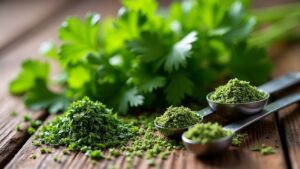If you’ve ever pondered whether fresh parsley packs more nutrients than dried, you’re not alone—many home cooks face this dilemma. While both forms offer health perks, their vitamin levels, mineral density, and even shelf life vary in surprising ways. Fresh parsley bursts with bright flavor and vitamins, but dried boasts concentrated antioxidants that could make it a stronger choice for certain dishes. Want to know which one suits your needs better? Let’s analyze the key differences.
Vitamin Content: Fresh vs. Dried Parsley
While fresh parsley packs a serious vitamin punch, dried parsley isn’t far behind—it just works a little differently.
Fresh parsley gives you a whopping 547% of your daily vitamin K needs (RDI), and dried parsley keeps most of that power, though exact amounts can vary. You’ll also get a solid dose of carotenoids—think of them as vitamin A helpers—which stay strong even whilst dried.
Vitamin C is higher in fresh parsley (53% RDI), but drying can lower it slightly. Still, dried parsley surprises with up to 17 times more antioxidant properties, helping fight cell damage.
Both forms deliver folate (11% RDI), supporting heart health. So whether you choose fresh or dried, you’re loading up on nutrients with real health benefits.
Just keep in mind: fresh shines in some areas, dried excels in others.
Mineral Concentration Differences
Because water makes up most of fresh parsley’s weight, drying it amps up the mineral content—giving you more iron, calcium, and potassium in every pinch.
While fresh parsley still packs these minerals, dried parsley wins in concentration since the drying process removes water, leaving behind a powerhouse of nutrients.
One will get up to 17 times more antioxidants and minerals like iron and calcium in dried parsley, making it a smarter choice should you be aiming to boost your health.
Fresh parsley is great for flavor and hydration, but when aiming for a bigger nutrient punch per serving, reach for the dried version.
Both options support your health, but dried parsley delivers minerals in a more compact, potent form.
Just a sprinkle can make a difference!
Antioxidant Levels and Stability
You could consider fresh parsley has the highest antioxidant levels, but drying actually concentrates them, making dried parsley a powerhouse.
While vitamin C breaks down during the process, other key antioxidants like flavonoids stay stable, keeping their health benefits intact.
Storing dried parsley properly—like in a dark, cool place—helps lock in those nutrients so you get the most from it.
Antioxidant Retention Comparison
While comparing the antioxidant levels in fresh and dried parsley, you might be surprised to find that drying actually boosts its nutritional punch. The drying process concentrates antioxidants like flavonoids and carotenoids, making dried parsley up to 17 times richer in these compounds than fresh.
Here’s what you need to know:
- Flavonoids & Carotenoids: These antioxidants stay stable in dried parsley, offering long-lasting health benefits.
- Vitamin C: Fresh parsley has more, but it’s heat-sensitive, while dried retains other antioxidant properties better.
- Convenience & Potency: Dried parsley packs more antioxidants per making it making it a powerhouse for healthfulness.
Whether you choose fresh or dried, both deliver nutritional benefits, but dried parsley’s concentrated antioxidant properties make it a standout for boosting meals.
Impact of Drying Process
At the time parsley goes through the drying process, it doesn’t just shrink—it becomes a condensed source of antioxidants that often outshines its fresh counterpart.
The impact of drying concentrates nutrients like carotenoids and polyphenols, making dried parsley up to 17 times richer in antioxidants.
While fresh parsley has more volatile oil compounds for flavor, the drying process preserves most health benefits by stabilizing these key nutrients.
Air-drying works best to maintain antioxidant levels, though some vitamins like C could dip slightly.
You’ll still get a boost in vitamins A and K, proving dried parsley isn’t just convenient—it’s a powerhouse.
The difference lies in how you use it: fresh for bright taste, dried for long-lasting nutrient density.
Storage and Shelf Life
Because fresh parsley starts losing its antioxidant punch soon after harvest, proper storage makes all the difference in keeping those nutrients intact.
Fresh parsley lasts about two weeks in the fridge, but dried parsley can stay potent for up to a year. The drying process actually concentrates its antioxidant levels, making it a smart choice for long-term nutrient retention.
- Fresh parsley: Wrap it in a damp paper towel, store it in a plastic bag, and keep it in the crisper drawer to slow nutrient loss.
- Dried parsley: Store it in an airtight container away from light and heat to lock in its health benefits.
- Antioxidant stability: Dried parsley’s carotenoids and polyphenols stay strong, while fresh parsley’s fade faster when exposed to air.
Choose wisely based on your needs—both have perks!
Flavor Intensity and Aromatic Properties
Fresh parsley bursts with a bright, herbaceous flavor that instantly elevates dishes like salads or garnishes, while dried parsley brings a subtler taste that blends well in long-cooked meals like soups and stews.
The fresh version has vibrant aromatic properties, making it perfect for dishes where one wants that crisp, lively flavor to stand out.
Dried parsley, though milder, has a more concentrated profile—just a teaspoon can match the flavor intensity of a tablespoon of fresh. It improves slow-cooked dishes because its flavor holds up under heat, melding seamlessly with other ingredients.
Should you be after a punchy, fresh taste, go for the leafy version. For deeper, layered cooking, dried works best.
Caloric and Macronutrient Comparison
In case you’re watching calories or tracking macros, here’s good news—whether you choose fresh or dried parsley, you’re getting a low-calorie, nutrient-friendly herb.
Both pack light on the scale but differ slightly in their macronutrient profiles due to drying.
- Caloric Density: Fresh parsley gives you about 11 calories per ½ cup, while dried parsley squeezes 6 calories into just a teaspoon—more concentrated but still low-calorie.
- Protein & Fat: Fresh parsley offers 0.4g of protein per serving, while dried bumps it up to 1.5g per tablespoon. Both are virtually fat-free, with under 0.1g per serving.
- Carbs & Fiber: Fresh parsley has around 2g of carbs and 1g of fiber, while dried keeps it similar but in smaller servings.
No matter your pick, parsley’s nutrient profile stays lean and light.
Shelf Life and Nutrient Retention Over Time
You may observe fresh parsley lasts about two weeks in the fridge, while dried parsley stays good for up to a year when stored right.
The way you store it affects nutrient retention—dried parsley keeps most vitamins and minerals but loses some vitamin C over time.
Comparing preservation methods shows dried parsley packs more antioxidants, though fresh offers higher moisture and crispness.
Storage Impact on Nutrients
Though dried parsley lasts longer, how you store it makes all the difference in keeping those nutrients intact. Fresh parsley needs careful handling to avoid spoilage, while dried parsley’s nutritional benefits depend on proper storage conditions. Here’s what you need to know:
- Fresh parsley: Store it in the fridge wrapped in a damp paper towel to slow wilting and nutrient loss. It’s delicate, so moisture and temperature swings speed up spoilage.
- Dried parsley: Keep it in an airtight container away from heat and light to maintain its concentrated source of vitamins and flavor retention.
- Both forms: Exposure to air degrades nutrients over time, so seal them tightly to maximize shelf life and nutrient retention.
Good storage guarantees you get the most from each sprinkle or handful!
Preservation Methods Comparison
Fresh and dried parsley each have their strengths in the context of staying fresh and keeping nutrients locked in over time. Fresh parsley lasts about two weeks in the fridge, while dried parsley can stay good for a year or more provided it’s stored properly.
Drying concentrates nutrients like antioxidants, making dried parsley up to 17 times richer in them, but it might lose some vitamin C. Both forms keep their nutrient density, with dried parsley packing more vitamin K per teaspoon.
Fresh parsley wins in flavor profile and volatile compounds, giving dishes a brighter taste. Should you desire a long shelf life and concentrated nutrients, go dried. For vibrant flavor and fresh nutrients, choose fresh. Your needs decide which preservation method works.
Optimal Uses for Maximum Nutritional Benefit
To get the most out of parsley’s nutrients, how and whenever you use it matters.
Fresh parsley shines in raw dishes or as a garnish, preserving its vibrant flavor and high levels of vitamin A and vitamin C.
Dried parsley, packed with concentrated antioxidants, works best in cooked meals like soups, where heat won’t strip its nutritional benefits.
Here’s how to maximize both:
- Fresh parsley: Toss it into salads, blend it into smoothies, or sprinkle it over finished dishes to lock in its crisp taste and health benefits.
- Dried parsley: Stir it into stews, sauces, or baked goods early on in cooking to let its deep flavor meld while retaining nutrients.
- Mix both: Combine fresh and dried in recipes to balance flavor and nutrient retention for a bigger health boost.
Store fresh parsley in the fridge and dried in a cool, dark spot to keep them potent.


